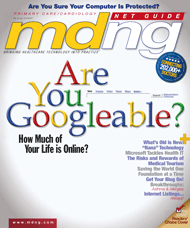Publication
Article
MDNG Primary Care
Tech Sector: Healthcare Moves from Static Websites to Dynamic Portals
Although life-saving advances in medicine may get the most media attention, the effects of recent improvements in healthcare information technology and the Internet are also quite important ...
Although life-saving advances in medicine may get the most media attention, the effects of recent improvements in healthcare information technology and the Internet are also quite important and should not be overlooked. They are allowing medical professionals not only to provide better treatment, but also to provide services to patients that enable them to communicate with their physicians without visiting the office or making a phone call. As more patients demand access to reasonably priced
healthcare services after practice hours, physicians will have to change their traditional business models to ensure high levels of patient satisfaction.
Many practices and hospitals have realized that, in addition to providing the best possible treatments, it’s also very important that they provide patients with critical support services, such as patient education, health and immunization alerts, and automated appointment scheduling. More than two-thirds of US residents believe that having access to health and medical information online would give them more control over their own care, according to a survey conducted by Lake Research Partners and American Viewpoint in November 2006. According to the survey, 27% of respondents felt that they currently have too little control over making healthcare decisions, and 82% of parents said they would be interested in tracking their children’s health records and services (such as immunization dates) online. Patients are becoming more Web savvy and are turning to the Internet for convenience, preferring self-service over waiting on the phone.
According to a recent Harris Interactive/Wall Street Journal survey, although 74% of respondents would like to be able to communicate with their physician via e-mail, a mere 4% currently use the technology. Further, 62% of respondents stated that the ability to communicate via e-mail with their physician would impact their physician choice “to some extent” or “a great deal.” Seventy-five percent of respondents also said they would like to be able to schedule appointments and perform other services online. With rising expectations, many practices and hospitals have revamped their static websites into fully functional, two-way patient portals to bridge the gap between the provider and the patient.
OmniMD’s Patient Portal offers patients a convenient, easy-to-use service they can use any time, anywhere through a secure Internet connection. The portal allows patients to log-in and request appointments, update or modify their health records, obtain personalized medical information, and view prescription history and information. The portal can also be used to refill prescriptions and transmit lab test requests. The OmniMD Patient Portals also use e-mail to send automated health alerts and patient education information. These two-way portals enable chronic care patients, for example, to quickly obtain answers to their questions, prescription refills or lab reports, and information on how to manage their own care, which can result in fewer office and hospital visits.
By delivering information and services to patients in a variety of ways, a fully functional patient portal helps maintain a seamless communication channel between patients and their providers, while improving overall efficiency of the delivery of care. Patient portals can be integrated with electronic medical record (EMR) software to provide a set of pre-defined functions and services for registered patients. Patients can request for selective access to their medical records, including lab reports, and can also schedule health reminders.
Patients can also use the portal to update or modify their demographics and family history, which can eliminate the need for data reentry and save valuable staff time. Hospitals and physician practices are increasingly relying on information technology solutions to help deliver better quality patient care while containing costs. With the increase in EMR adoption, patient portals will be a big part of the push for enhanced continuity of care, and will also help improve the patient—provider relationship.
For more information on OmniMD, the developer of HIPAA-compliant enterprise clinical solutions, visit the company’s website or contact the author at 914-332-5590 or ddave@omnimd.com.






